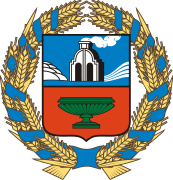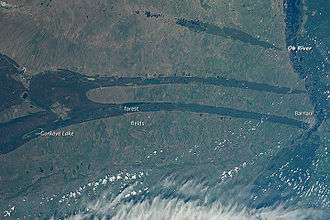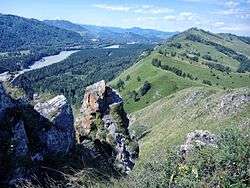Altai Krai
Altai Krai (Russian: Алта́йский край, tr. Altaysky kray, IPA: [ɐlˈtajskʲɪj kraj]) is a federal subject of Russia (a krai). It borders clockwise from the west, Kazakhstan (East Kazakhstan Region and Pavlodar Region), Novosibirsk and Kemerovo Oblasts, and the Altai Republic. The krai's administrative center is the city of Barnaul. As of the 2010 Census, the population of the krai was 2,419,755.[9]
Altai Krai | |
|---|---|
| Алтайский край | |
 Coat of arms | |
| Anthem: [1] | |
 | |
| Coordinates: 52°46′N 82°37′E | |
| Country | Russia |
| Federal district | Siberian[2] |
| Economic region | West Siberian[3] |
| Established | September 28, 1937[4] |
| Administrative center | Barnaul[5] |
| Government | |
| • Body | Altai Krai Legislative Assembly[6] |
| • Governor[7] | Viktor Tomenko |
| Area | |
| • Total | 169,100 km2 (65,300 sq mi) |
| Area rank | 22nd |
| Population (2010 Census)[9] | |
| • Total | 2,419,755 |
| • Estimate (2018)[10] | 2,350,080 (-2.9%) |
| • Rank | 21st |
| • Density | 14/km2 (37/sq mi) |
| • Urban | 54.7% |
| • Rural | 45.3% |
| Time zone | UTC+7 (MSK+4 |
| ISO 3166 code | RU-ALT |
| License plates | 22 |
| OKTMO ID | 01000000 |
| Official languages | Russian[12] |
| Website | http://www.altairegion22.ru |
Name
The region is named after the Altai mountains.[13] In Russian, Altai Krai means the Altai region.
Geography


Altai Krai has rolling foothills, grasslands, lakes, rivers, and mountains.[14]
The climate is severe with long cold dry winters and hot, usually dry summers. The region's main waterway is the Ob River. The Biya and Katun Rivers are also important. The biggest lakes are Lake Kulundinskoye, Lake Kuchukskoye, and Lake Mikhaylovskoye.[15]
Altai Krai has rich natural resources, including lumber, as well as significant mineral reserves. These include the nonferrous metals lead, manganese, tungsten, molybdenum, bauxite, and gold, as well as iron ore. Forests cover about 60,000 km2 (23,000 sq mi) of the krai's land.[15] See also Geography of South-Central Siberia.
This region of Siberia is extremely important due to its biodiversity, an area of over 1.6 million hectares (16,000 square kilometres; 6,200 square miles) is recognised by Unesco as a world heritage site. The area is home to animals considered rare, including the endangered snow leopard.
History
Bone fragments of the Denisova hominin originate from the Denisova Cave in Altai Krai.
This area is part of a great crossroads in the ancient world.[16] Nomadic tribes crossed through the territory during periods of migration. These nomadic tribes consisted of different peoples. Archeological sites reveal that ancient humans lived in the area.[15] The Altay people are a Turkic people, some of whom settled here, who were originally nomadic and date back to the 2nd millennium BCE.[17]
The territory of the krai has been controlled by the Xiongnu Empire (209 BC-93 CE), the Rouran Khaganate (330-555), the Mongol Empire (1206-1368), the Golden Horde, the Northern Yuan (1368-1691) and the Zunghar Khanate (1634–1758).[18]
After the Russian Revolution and the rise of the Russian Soviet Federative Socialist Republic, the policy of war communism was imposed on the rural population of Altai Krai, destroying the livelihood of many local farmers. In response, the peasant rebellion of Sorokino broke out in 1921; this uprising was quickly crushed by the Red Army. Many locals who had taken part in the rebellion were later put on trial and convicted to hard labor or execution, in accordance with NKVD Order No. 00447 in 1937.[19]
During the interwar period, the Soviet state collectivised the livestock and husbandry activities of the Altai population within Altai Krai, resulting in local resistance to the measures and their subsequent migration, with their herds, to China and Mongolia.[20]
In June 1942 Altai Krai was one of the territories to which the families of men deported from Eastern Europe, in particular "foreigners" and "other ethnicities" such as Kola Norwegians, Lithuanians and Latvians, by Soviet Russia to hard labor camps.[21]
Administrative divisions
Heraldry
Flag
The flag of Altai Krai is red, with the leftmost portion blue. The blue portion contains, in golden yellow, a stylized depiction of an upright ear of wheat. Centered in the red field is the coat of arms of the territory.
Coat of arms
The coat of arms of Altai Krai was established in 2000. It includes a shield of French heraldry form with a basement of 8/10th of its height and a sharp part in the middle of the bottom part. Bottom edges of the shield are rounded. The shield is divided with a horizontal stripe into two equal parts. In the upper part has a blue background, which is a symbol of glory, is a steamy oven of the 18th century, which reflects a historical past of the krai. In the bottom part on the red background, which is a symbol of dignity, braveness and courage, is an image of the Koluvan Queen of Vases mainly in green color, which is kept in the Hermitage Museum. The shield is framed with golden wheat ears which represent agriculture as a main industry of Altai Krai.

Politics
During the Soviet period, the high authority in the krai was shared between three persons: The first secretary of the Altai CPSU Committee (who in reality had the most authority), the chairman of the Krai Soviet (legislative power), and the Chairman of the Krai Executive Committee (executive power). Since 1991, CPSU lost all the power, and the head of the krai administration, and eventually the governor was appointed/elected alongside elected regional parliament.
The Charter of Altai Krai is the fundamental law of the region. The Legislative Assembly of Altai Krai is the regional standing legislative (representative) body. The Legislative Assembly exercises its authority by passing laws, resolutions, and other legal acts and by supervising the implementation and observance of the laws and other legal acts passed by it. The highest executive body is the Krai Government, which includes territorial executive bodies such as district administrations, committees, and commissions that facilitate development and run the day to day matters of the province. The Krai Administration supports the activities of the Governor who is the highest official and acts as guarantor of the observance of the krai Charter in accordance with the Constitution of Russia.
On August 7, 2005, the krai's then-head of administration Mikhail Yevdokimov died in a car crash.
List of Chairmen of the Altai Krai Legislative Assembly
The Chairman of the Altai Krai Legislative Assembly is the presiding officer of that legislature.
Economy
As of 2013 the Krai's largest enterprises were supermarket chain Maria-Ra, coke fuel producer Altai-Koks and rolling stock manufacturer Altaivagon.[24] Evalar - a prominent dietary supplement manufacturer - is also located in Altai Krai.
In January 2019, the average wage in Altai Krai was 23,941 RUB, which was an increase of 6.3% over the previous year.[25]
Demographics
Population: 2,390,638 (2014 est.);[26] 2,419,755 (2010 Census);[9] 2,607,426 (2002 Census);[27] 2,822,305 (1989 Census).[28]
As of the 2010 Census,[9] Russians form an overwhelming majority of the population, at 93.9%. Germans are the second-largest group, at 2.1% (see Mennonite settlements of Altai and the German National District). Other groups include Ukrainians (1.4%), Kazakhs (0.3%), Tatars (0.3%), Belarusians (0.2%), Armenians (0.3%), and people of other ethnicities. Additionally, 40,984 people were registered from administrative databases, and could not declare an ethnicity. It is estimated that the proportion of ethnicities in this group is the same as that of the declared group.[29]
- Vital statistics for 2012
2009 - 1.62 | 2010 - 1.63 | 2011 - 1.65 | 2012 - 1.81 | 2013 - 1.83 | 2014 - 1.84 | 2015 - 1.81 | 2016 - 1.79(e)
Settlements
Religion
According to a 2012 survey[33] 22.6% of the population of Altay Krai adheres to the Russian Orthodox Church, 3% are unaffiliated Christians, 1% are Orthodox Christian believers without belonging to any church or are adherents of other Orthodox churches, 1% are adherents of Islam. In addition, 31% of the population declares to be "spiritual but not religious", 27% is atheist, and 14.4% follows other religions or did not give an answer to the question.[33]
Sister district
See also
- Altai Mountains
- Sayan Mountains
- Denisova Cave
- List of Chairmen of the Altai Krai Legislative Assembly
References
Notes
- Article 6 of the Charter of Altai Krai states that the symbols of the krai include a flag and a coat of arm, but there is no provision for an anthem.
- Президент Российской Федерации. Указ №849 от 13 мая 2000 г. «О полномочном представителе Президента Российской Федерации в федеральном округе». Вступил в силу 13 мая 2000 г. Опубликован: "Собрание законодательства РФ", No. 20, ст. 2112, 15 мая 2000 г. (President of the Russian Federation. Decree #849 of May 13, 2000 On the Plenipotentiary Representative of the President of the Russian Federation in a Federal District. Effective as of May 13, 2000.).
- Госстандарт Российской Федерации. №ОК 024-95 27 декабря 1995 г. «Общероссийский классификатор экономических регионов. 2. Экономические районы», в ред. Изменения №5/2001 ОКЭР. (Gosstandart of the Russian Federation. #OK 024-95 December 27, 1995 Russian Classification of Economic Regions. 2. Economic Regions, as amended by the Amendment #5/2001 OKER. ).
- Resolution of September 28, 1937
- Charter of Altai Krai, Article 6
- Charter of Altai Krai, Article 67
- Charter of Altai Krai, Article 79
- Федеральная служба государственной статистики (Federal State Statistics Service) (May 21, 2004). "Территория, число районов, населённых пунктов и сельских администраций по субъектам Российской Федерации (Territory, Number of Districts, Inhabited Localities, and Rural Administration by Federal Subjects of the Russian Federation)". Всероссийская перепись населения 2002 года (All-Russia Population Census of 2002) (in Russian). Federal State Statistics Service. Retrieved November 1, 2011.
- Russian Federal State Statistics Service (2011). "Всероссийская перепись населения 2010 года. Том 1" [2010 All-Russian Population Census, vol. 1]. Всероссийская перепись населения 2010 года [2010 All-Russia Population Census] (in Russian). Federal State Statistics Service.
- "26. Численность постоянного населения Российской Федерации по муниципальным образованиям на 1 января 2018 года". Federal State Statistics Service. Retrieved January 23, 2019.
- "Об исчислении времени". Официальный интернет-портал правовой информации (in Russian). June 3, 2011. Retrieved January 19, 2019.
- Official throughout the Russian Federation according to Article 68.1 of the Constitution of Russia.
- Warikoo, K. (2017). Eurasia and India: Regional Perspectives. Routledge. ISBN 9781351691956.CS1 maint: ref=harv (link)
- "Russian program — Altai". Archived from the original on March 22, 2007. Retrieved November 30, 2006.
- "Altai Territory". Archived from the original on November 4, 2006. Retrieved November 29, 2006.
- "Greater Altai – Altai Krai, Republic of Altai, Tyva (Tuva), and Novosibirsk — Crossroads". Archived from the original on March 14, 2007. Retrieved November 30, 2006.
- "Peoples from Russia — Alexey, guide in Altay region". Archived from the original on December 30, 2006. Retrieved November 30, 2006.
- History of Mongolia, Volume II, 2003
- Jusopova (2010), p. 91–109.
- Olson, James Stuart (1998). An ethnohistorical dictionary of China. Greenwood Publishing Group. p. 11. ISBN 9780313288531.CS1 maint: ref=harv (link)
- Lietuvos žydų tremtinių sąrašas Parengė Galina Žirikova pagal: „Genocido aukų vardynas 1939-1941 m.“ Lietuvos gyventojų genocido ir rezistencijos centras. 1998-2005 m.
- "АЛЕЙНИКОВ АНДРЕЙ АНАТОЛЬЕВИЧ / «Российская Федерация» / III выпуск / ВСЕ ГЕРОИ ЭНЦИКЛОПЕДИИ / Издательство «Спец-Адрес»". www.llr.ru. Retrieved July 17, 2018.
- "Altai Krai Legislative Assembly". Archived from the original on April 17, 2013. Retrieved July 17, 2018.
- "Новости, анализ, прогнозы в сфере экономики и бизнеса, общества и политики". expert.ru. Retrieved October 12, 2018.
- https://tolknews.ru/news/10323-kakova-srednaa-zarplata-v-altajskom-krae
- Altai Krai Territorial Branch of the Federal State Statistics Service. Оценка численности населения на 1 января 2014 года и в среднем за 2013 год Archived October 19, 2015, at the Wayback Machine (in Russian)
- Russian Federal State Statistics Service (May 21, 2004). "Численность населения России, субъектов Российской Федерации в составе федеральных округов, районов, городских поселений, сельских населённых пунктов – районных центров и сельских населённых пунктов с населением 3 тысячи и более человек" [Population of Russia, Its Federal Districts, Federal Subjects, Districts, Urban Localities, Rural Localities—Administrative Centers, and Rural Localities with Population of Over 3,000] (XLS). Всероссийская перепись населения 2002 года [All-Russia Population Census of 2002] (in Russian).
- "Всесоюзная перепись населения 1989 г. Численность наличного населения союзных и автономных республик, автономных областей и округов, краёв, областей, районов, городских поселений и сёл-райцентров" [All Union Population Census of 1989: Present Population of Union and Autonomous Republics, Autonomous Oblasts and Okrugs, Krais, Oblasts, Districts, Urban Settlements, and Villages Serving as District Administrative Centers]. Всесоюзная перепись населения 1989 года [All-Union Population Census of 1989] (in Russian). Институт демографии Национального исследовательского университета: Высшая школа экономики [Institute of Demography at the National Research University: Higher School of Economics]. 1989 – via Demoscope Weekly.
- Перепись-2010: русских становится больше. Perepis-2010.ru (2011-12-19). Retrieved on 2013-08-20.
- Естественное движение населения в разрезе субъектов Российской Федерации. Gks.ru. Retrieved on 2013-08-20.
- Естественное движение населения в разрезе субъектов Российской Федерации. Gks.ru. Retrieved on 2013-08-20.
- Каталог публикаций::Федеральная служба государственной статистики. Gks.ru (2010-05-08). Retrieved on 2013-08-20.
- "Arena: Atlas of Religions and Nationalities in Russia". Sreda, 2012.
- 2012 Arena Atlas Religion Maps. "Ogonek", № 34 (5243), 27/08/2012. Retrieved 21/04/2017. Archived.
- "China and Russia sister cities". Archived from the original on November 12, 2008. Retrieved July 17, 2018.
Sources
- Алтайское краевое Законодательное Собрание. №3-ЗС 5 июня 1995 г. «Устав (основной закон) Алтайского края», в ред. Закона №118-ЗС от 1 декабря 2015 г. «О внесении изменений в Устав (Основной Закон) Алтайского края». Опубликован: "Алтайская правда", №100, 14 июня 1995 г. (Altai Krai Legislative Assembly. #3-ZS June 5, 1995 Charter (Basic Law) of Altai Krai, as amended by the Law #118-ZS of December 1, 2015 On Amending the Charter (Basic Law) of Altai Krai. ).
- Центральный исполнительный комитет СССР. Постановление от 28 сентября 1937 г. «О разделении Западно-Сибирского края на Новосибирскую область и Алтайский край». (Central Executive Committee of the USSR. Resolution of September 28, 1937 On Splitting West Siberian Krai into Novosibirsk Oblast and Altai Krai. ).
- Jusopova, Evgenija (2010). "Vorgehen gegen die Teilnehmer des Aufstandes von Sorokino in der Altaj-Region". In Rolf Binner; Bernd Bonwetsch; Marc Junge (eds.). Stalinismus in der sowjetischen Provinz 1937–1938. Die Massenaktion aufgrund des operativen Befehls No. 00447 (in German). Berlin: Akademie Verlag. pp. 91–109. ISBN 978-3-05-004685-3.CS1 maint: ref=harv (link)
External links
| Wikivoyage has a travel guide for Altai Krai. |
| Wikimedia Commons has media related to Altai Krai. |
- Official website of Altai Krai
- Official website of Altai Krai (in Russian)
- Kommersant.com. Information about Altai Krai
- Library of Congress Russian (pdf)
- History of Altai Krai
- Altai: a living spirit

_2.jpg)